Naval Radar Market
Naval Radar Market Size and Share Forecast Outlook 2025 to 2035
Naval radar market is projected to grow from USD 6.2 billion in 2025 to USD 9.0 billion by 2035, at a CAGR of 3.8%. S/X-band will dominate with a 49.0% market share, while aesa will lead the technology segment with a 54.0% share.
Naval Radar Market Forecast and Outlook 2025 to 2035
The naval radar market stands at the threshold of a decade-long expansion trajectory that promises to reshape maritime defense technology and naval surveillance solutions. The market's journey from USD 6.2 billion in 2025 to USD 9 billion by 2035 represents substantial growth, the market will rise at a CAGR of 3.8% which demonstrating the accelerating adoption of advanced radar technology and naval optimization across defense facilities, surface combatants, and maritime security sectors.
Quick Stats for Naval Radar Market
- Naval Radar Market Value (2025): USD 6.2 billion
- Naval Radar Market Forecast Value (2035): USD 9 billion
- Naval Radar Market Forecast CAGR: 3.8%
- Leading Band Type in Naval Radar Market: S/X-band radars
- Key Growth Regions in Naval Radar Market: North America, Europe, and Asia Pacific
- Top Players in Naval Radar Market: Thales, Raytheon, Lockheed Martin, Hensoldt, Leonardo
- Where revenue comes from - Now Vs Next (Industry-level view)
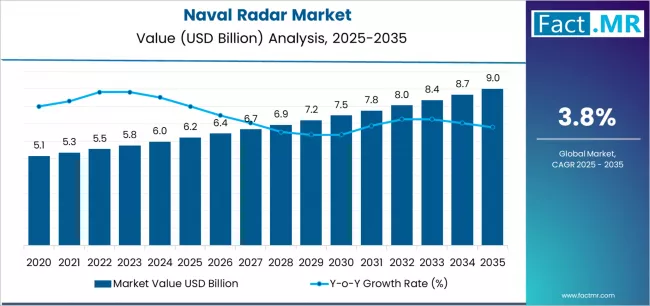
The first half of the decade (2025-2030) will witness the market climbing from USD 6.2 billion to approximately USD 7.4 billion, adding USD 1.2 billion in value, which constitutes 43% of the total forecast growth period. This phase will be characterized by the rapid adoption of S/X-band radar systems, driven by increasing naval modernization requirements and the growing need for advanced maritime surveillance solutions worldwide. Enhanced detection capabilities and automated tracking systems will become standard expectations rather than premium options.
The latter half (2030-2035) will witness continued growth from USD 7.4 billion to USD 9 billion, representing an addition of USD 1.6 billion or 57% of the decade's expansion. This period will be defined by mass market penetration of AESA radar technologies, integration with comprehensive naval combat platforms, and seamless compatibility with existing fleet infrastructure. The market trajectory signals fundamental shifts in how naval forces approach maritime surveillance and threat detection, with participants positioned to benefit from growing demand across multiple radar bands and platform segments.
| Period | Primary Revenue Buckets | Share | Notes |
|---|---|---|---|
| Today | S/X-band radars | 49% | Multi-role capability, proven performance |
| L/C-band radars | 31% | Long-range detection, air surveillance | |
| Other bands | 20% | Specialized applications, niche requirements | |
| Future (3-5 yrs) | Advanced S/X systems | 51-55% | AESA integration, multi-function capability |
| Enhanced L/C platforms | 29-33% | Extended range, improved accuracy | |
| Next-generation bands | 14-18% | Emerging technologies, specialized missions | |
| Integrated radar networks | 2-4% | Multi-platform connectivity, data fusion |
Naval Radar Market Key Takeaways
At-a-Glance Metrics
| Metric | Value |
|---|---|
| Market Value (2025) → | USD 6.2 billion |
| Market Forecast (2035) ↑ | USD 9 billion |
| Growth Rate ★ | 3.8% CAGR |
| Leading Band → | S/X-band radars |
| Primary Technology → | AESA |
The market demonstrates strong fundamentals with S/X-band radars capturing a dominant share through advanced multi-role capabilities and naval optimization. AESA technology drives primary demand, supported by increasing detection accuracy requirements and electronic warfare resistance standards. Geographic expansion remains concentrated in developed markets with established naval infrastructure, while emerging economies show accelerating adoption rates driven by maritime security initiatives and rising naval modernization standards.
Imperatives for Stakeholders in Naval Radar Market
Design for threat detection, not just surveillance capability
- Offer naval packages: radar systems + combat integration + training support + technical specialists + performance validation.
- Preconfigured workflows: deployment protocols, maintenance procedures, threat assessment, and digital tracking on naval projects.
Technology readiness for modern warfare
- Real-time threat analysis, electronic warfare resistance, and naval integration (combat systems, weapon control platforms).
Performance-by-design approach
- Automated tracking systems, real-time threat mechanisms, statistical performance monitoring integration, and paperless documentation.
Value-based defense models
- Clear base radar price + transparent service tiers (training support, maintenance programs, upgrade guarantees); subscriptions for threat intelligence services and performance analytics.
Segmental Analysis
Primary Classification: The market segments by band into S/X-band, L/C-band, and other frequency systems, representing the evolution from basic radar detection to specialized multi-function solutions for comprehensive naval surveillance, threat detection, and combat optimization.
Secondary Classification: Technology segmentation divides the market into AESA (54%) and PESA/Mechanized (46%) sectors, reflecting distinct requirements for detection accuracy, electronic warfare resistance, and operational characteristics.
Platform Classification: Platform segmentation covers surface combatants (62%), submarines (14%), and patrol/auxiliaries (24%) categories, addressing different naval requirements from major warships to specialized vessels.
The segmentation structure reveals technology progression from traditional mechanical radars toward specialized AESA systems with enhanced detection consistency and electronic warfare capabilities, while platform diversity spans from destroyers to patrol craft requiring precise radar solutions.
By Band, the S/X-band Segment Accounts for Dominant Market Share
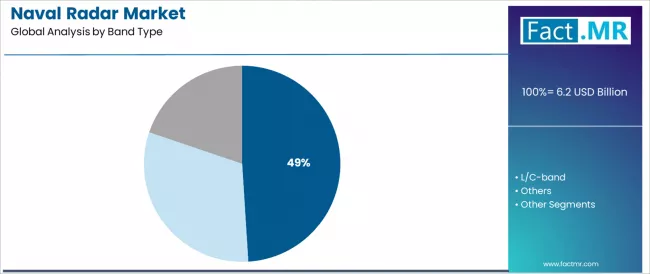
Market Position: S/X-band naval radars command the leading position in the naval radar market with 49% market share through advanced multi-role features, including superior detection characteristics, target discrimination, and combat integration that enable naval forces to achieve optimal surveillance across diverse surface combatant and maritime applications.
Value Drivers: The segment benefits from naval preference for versatile radar systems that provide consistent detection performance, multi-target tracking, and combat optimization without requiring significant platform modifications. Advanced S/X-band features enable automated threat assessment, electronic countermeasures, and integration with existing naval equipment, where detection accuracy and combat effectiveness represent critical operational requirements.
Competitive Advantages: S/X-band radars differentiate through proven multi-role reliability, consistent detection characteristics, and integration with automated combat systems that enhance naval effectiveness while maintaining optimal operational standards for diverse surface combatant and maritime applications.
Key market characteristics:
- Advanced S/X designs with optimized frequency configuration and multi-target capabilities
- Enhanced naval effectiveness, enabling 85-90% threat detection accuracy with reliable performance
- Combat compatibility, including automated tracking systems, weapon integration, and process optimization for naval performance
L/C-band Systems Show Strong Long-Range Applications
L/C-band systems maintain a 31% market position in the naval radar market due to their proven long-range detection and air surveillance characteristics. These systems appeal to navies requiring extended coverage with competitive positioning for area defense and early warning applications. Market growth is driven by surveillance segment expansion, emphasizing reliable long-range solutions and operational efficiency through proven designs.
Other Bands Serve Specialized Requirements
Other bands account for 20% market share, serving specialized applications requiring unique frequency properties and mission-specific characteristics for advanced naval requirements.
By Technology, the AESA Segment Shows Market Leadership
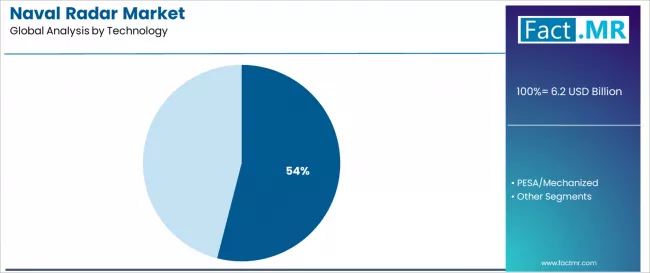
Market Context: AESA (Active Electronically Scanned Array) technology demonstrates market leadership in the naval radar market with 54% share due to widespread adoption of advanced electronic systems and increasing focus on detection accuracy, electronic warfare resistance, and multi-target capability that maximize naval performance while maintaining operational standards.
Appeal Factors: Naval forces prioritize AESA reliability, beam steering capability, and integration with existing combat infrastructure that enables coordinated surveillance operations across multiple threat scenarios. The segment benefits from substantial naval investment and modernization programs that emphasize the acquisition of advanced radar systems for threat detection and combat effectiveness applications.
Growth Drivers: Naval modernization programs incorporate AESA systems as standard components for surveillance operations, while threat sophistication trends increase demand for consistent detection capabilities that comply with naval standards and minimize vulnerability risks.
Application dynamics include:
- Strong growth in modern naval platforms requiring advanced detection capabilities
- Increasing adoption in electronic warfare resistance and multi-target applications for naval forces
- Rising integration with combat management systems for operational optimization and threat assurance
PESA/Mechanized Applications Maintain Strong Legacy Demand
PESA/Mechanized applications capture 46% market share through comprehensive requirements in existing platforms, cost-effective solutions, and proven naval systems. These facilities demand reliable radar systems capable of operating in established environments while providing effective detection integration and surveillance capabilities.
By Platform, the Surface Combatants Segment Leads Market Share
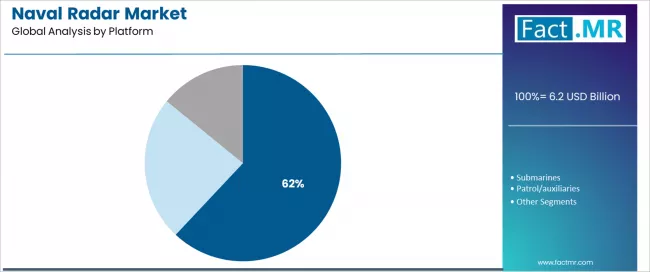
The surface combatants segment commands 62% market share through widespread adoption in major warship applications, destroyer platforms, and frigate operations. These systems provide advanced radar solutions for comprehensive naval requirements while maintaining detection consistency and combat reliability.
Submarines Systems Show Strong Specialized Demand
Submarines systems capture 14% market share, serving underwater platforms, periscope detection, and specialized naval operations requiring enhanced stealth capabilities for maritime surveillance and tactical effectiveness.
Patrol/Auxiliaries Applications Show Support Growth
Patrol/auxiliaries applications account for 24% market share, addressing coastal patrol, support vessels, and maritime security requiring efficient radar solutions for surveillance optimization and operational enhancement.
What are the Drivers, Restraints, and Key Trends of the Naval Radar Market?
| Category | Factor | Impact | Why It Matters |
|---|---|---|---|
| Driver | Naval modernization & fleet expansion (warship construction, capability upgrade) | ★★★★★ | Large-scale naval modernization requires advanced radar solutions with consistent quality and detection integration across maritime defense applications. |
| Driver | Maritime threats & territorial disputes (regional tensions, piracy concerns) | ★★★★★ | Drives demand for sophisticated surveillance solutions and threat-detection capabilities; suppliers providing advanced radar systems gain competitive advantage. |
| Driver | Electronic warfare evolution & countermeasures (jamming resistance, stealth detection) | ★★★★☆ | Naval forces need advanced, resilient radar solutions; demand for electronic warfare-resistant systems expanding addressable market segments. |
| Restraint | High development costs & budget constraints (R&D investment, procurement limitations) | ★★★★☆ | Budget-conscious navies face investment pressure; increases cost barriers and affects adoption in defense segments with limited procurement budgets. |
| Restraint | Technology complexity & integration challenges (system complexity, platform integration) | ★★★☆☆ | Advanced-capability operations face integration challenges; complex requirements limiting adoption in less sophisticated naval segments. |
| Trend | Multi-function radars & system integration (combined capabilities, platform optimization) | ★★★★★ | Growing demand for integrated radar solutions; multi-function capabilities become core value proposition in modern naval platforms. |
| Trend | AI integration & autonomous threat detection (machine learning, automated response) | ★★★★☆ | Technology advancement drives demand for intelligent radar solutions; AI capabilities drive differentiation toward autonomous naval applications. |
Analysis of the Naval Radar Market by Key Country
The naval radar market demonstrates varied regional dynamics with growth leaders including United States (4.5% growth rate) and Mexico (4.2% growth rate) driving expansion through naval modernization initiatives and maritime security enhancement. Strong Performers encompass Germany (3.7% growth rate), France (3.6% growth rate), and United Kingdom (3.3% growth rate), benefiting from established naval industries and defense procurement programs. Mature Markets feature South Korea (3.2% growth rate) and Japan (3.1% growth rate), where naval optimization and maritime defense requirements support consistent growth patterns.
Regional synthesis reveals North American markets leading adoption through naval expansion and maritime security trends, while European countries maintain steady expansion supported by NATO requirements and naval modernization standards. Emerging markets show strong growth driven by territorial defense applications and maritime security enhancement trends.
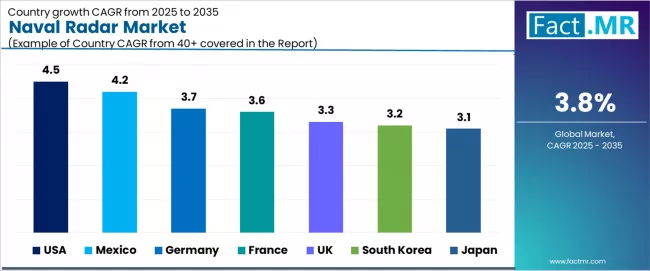
| Region/Country | 2025-2035 Growth | How to win | What to watch out |
|---|---|---|---|
| United States | 4.5% | Focus on advanced AESA systems | Budget constraints; program delays |
| Mexico | 4.2% | Value-oriented maritime security applications | Limited naval budget; technology transfer restrictions |
| Germany | 3.7% | Offer NATO-compatible systems | Export controls; industrial competition |
| France | 3.6% | Provide multi-role naval solutions | Budget limitations; technological complexity |
| United Kingdom | 3.3% | Push advanced defense technologies | Post-Brexit defense relationships; cost pressures |
| South Korea | 3.2% | Lead with shipbuilding integration | Regional tensions; technology dependency |
| Japan | 3.1% | Premium naval positioning | Constitutional constraints; regional security concerns |
United States Drives Fastest Market Growth
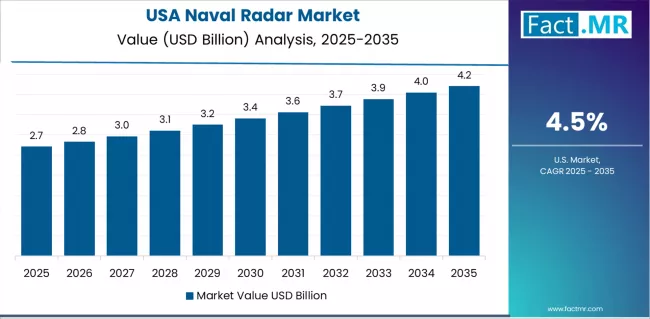
United States establishes fastest market growth through comprehensive naval modernization programs and extensive maritime defense development, integrating advanced naval radar systems as standard components in naval facilities, surface combatants, and maritime installations. The country's 4.5% growth rate reflects defense initiatives promoting naval advancement and surveillance optimization capabilities that mandate the use of advanced radar systems in naval projects. Growth concentrates in major naval regions, including Virginia, California, and Connecticut, where naval technology development showcases integrated radar systems that appeal to naval forces seeking advanced detection capabilities and combat optimization applications.
American manufacturers are developing high-performance naval radar solutions that combine domestic defense advantages with advanced detection features, including AESA systems and enhanced electronic warfare compatibility. Distribution channels through defense contractors and naval service distributors expand market access, while naval investment support for fleet modernization supports adoption across diverse naval segments.
Strategic Market Indicators:
- Naval forces leading adoption with 83% deployment rate in surface combatants and maritime defense sectors
- Government naval programs providing substantial support for domestic maritime defense technology development
- Local radar manufacturers capturing 58% market share through competitive pricing and localized naval support
- Export market development for advanced naval radars targeting allied maritime forces
Mexico Emerges as High-Growth Market
In Mexico's maritime regions, including coastal states and naval facilities, naval operations and maritime security forces are implementing advanced radar systems as standard components for surveillance enhancement and territorial protection, driven by increasing maritime security investment and naval modernization programs that emphasize the importance of detection capabilities. The market holds a 4.2% growth rate, supported by government maritime security initiatives and naval development programs that promote advanced radar systems for naval applications. Mexican operators are adopting radar systems that provide consistent detection performance and cost-effectiveness features, particularly appealing in maritime regions where territorial surveillance and maritime security represent critical operational requirements.
Market expansion benefits from growing naval capabilities and maritime security agreements that enable domestic deployment of effective radar systems for naval applications. Technology adoption follows patterns established in maritime security, where effectiveness and reliability drive procurement decisions and operational deployment.
Germany Shows Naval Technology Leadership
Germany's advanced naval technology market demonstrates sophisticated radar system deployment with documented operational effectiveness in NATO applications and naval projects through integration with existing naval systems and maritime infrastructure. The country leverages engineering expertise in naval technology and maritime integration to maintain a 3.7% growth rate. Naval centers, including Schleswig-Holstein, Lower Saxony, and Mecklenburg-Vorpommern, showcase premium installations where radar systems integrate with comprehensive naval platforms and maritime management systems to optimize detection operations and naval effectiveness.
German manufacturers prioritize detection precision and NATO compliance in product development, creating demand for premium systems with advanced features, including electronic warfare resistance and automated naval systems. The market benefits from established naval infrastructure and willingness to invest in advanced radar technologies that provide long-term maritime benefits and compliance with international naval standards.
France Shows Naval Integration Focus
France establishes naval integration focus through comprehensive maritime modernization and naval development, integrating radar systems across naval facilities and maritime operations. The country's 3.6% growth rate reflects mature naval relationships and established maritime adoption that supports widespread use of radar systems in French and European facilities. Growth concentrates in major naval centers, including Brittany, Provence-Alpes-Côte d'Azur, and Nouvelle-Aquitaine, where naval technology showcases mature radar deployment that appeals to operators seeking proven naval capabilities and maritime optimization applications.
French manufacturers leverage established naval networks and comprehensive maritime capabilities, including naval programs and technical support that create operational relationships and naval advantages. The market benefits from mature naval standards and maritime requirements that mandate radar system use while supporting technology advancement and naval optimization.
United Kingdom Shows Advanced Naval Development
United Kingdom establishes advanced naval development through comprehensive maritime modernization and technology integration, integrating radar systems across naval and maritime applications. The country's 3.3% growth rate reflects growing naval investment and increasing adoption of radar technology that supports expanding use of advanced systems in UK naval facilities. Growth concentrates in major naval areas, including South West, South East, and Scotland, where naval technology development showcases integrated radar systems that appeal to UK naval forces seeking advanced detection solutions with maritime compatibility.
UK manufacturers focus on maintaining naval standards while adopting advanced maritime positioning, creating demand for systems that balance performance with operational advantages. The market benefits from strong naval infrastructure and growing maritime opportunities that support radar technology adoption while maintaining naval standards important to UK maritime applications.
Europe Market Split by Country
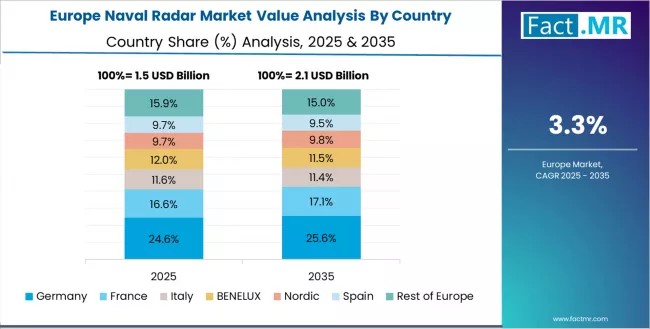
The naval radar market in Europe is projected to grow from USD 1.8 billion in 2025 to USD 2.5 billion by 2035, registering a CAGR of 3.4% over the forecast period. Germany is expected to maintain its leadership position with a 26.7% market share in 2025, declining slightly to 26.2% by 2035, supported by its advanced naval infrastructure and major maritime defense facilities including naval bases in Schleswig-Holstein and Lower Saxony.
France follows with a 22.6% share in 2025, projected to reach 23.1% by 2035, driven by comprehensive naval programs and maritime defense modernization strategies. The United Kingdom holds a 20.1% share in 2025, expected to decrease to 19.6% by 2035 due to post-Brexit naval program adjustments. Italy commands a 16.2% share, while Spain accounts for 13.2% in 2025. The Rest of Europe region is anticipated to gain momentum, expanding its collective share from 1.2% to 1.3% by 2035, attributed to increasing naval modernization adoption in Nordic countries and emerging Eastern European naval facilities implementing maritime defense programs.
Japan Demonstrates Naval Precision Focus
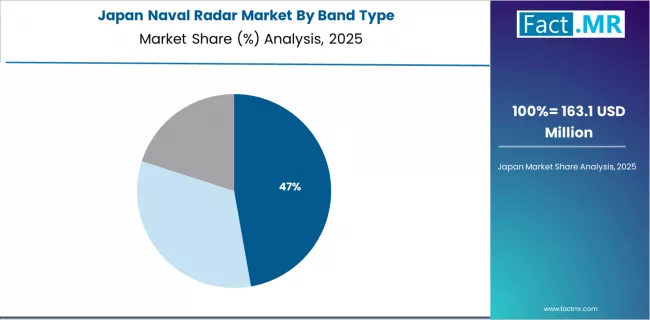
Japan's advanced naval technology market demonstrates sophisticated radar system deployment with documented operational effectiveness in maritime self-defense applications and naval projects through integration with existing naval systems and maritime infrastructure. The country maintains a 3.1% growth rate, leveraging traditional naval expertise and systematic integration in radar technology. Naval centers, including Yokosuka, Sasebo, and Maizuru, showcase premium installations where radar systems integrate with traditional naval platforms and modern maritime management systems to optimize maritime operations and maintain naval quality profiles.
Japanese manufacturers prioritize naval precision and quality consistency in radar development, creating demand for premium systems with advanced features, including quality monitoring and automated naval systems. The market benefits from established precision infrastructure and commitment to naval standards that provide long-term maritime benefits and compliance with traditional precision naval methods.
South Korea Shows Naval Innovation Development
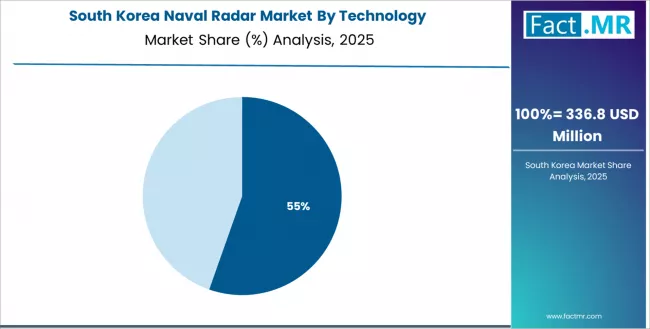
South Korea establishes naval innovation development through comprehensive maritime modernization and technology integration, integrating radar systems across naval-focused maritime and defense applications. The country's 3.2% growth rate reflects growing naval investment and increasing adoption of radar technology that supports expanding use of advanced systems in Korean naval facilities. Growth concentrates in major naval areas, including Busan, Incheon, and Jeju, where naval technology development showcases integrated radar systems that appeal to Korean naval forces seeking advanced detection solutions with maritime compatibility.
Korean manufacturers focus on maintaining innovation standards while adopting naval-integrated efficiency, creating demand for systems that balance performance with technological advantages. The market benefits from strong naval infrastructure and growing innovation opportunities that support radar technology adoption while maintaining quality standards important to Korean naval applications.
Competitive Landscape of the Naval Radar Market
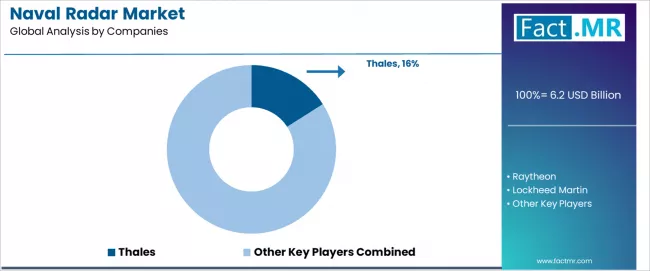
- Structure: ~10-12 credible players; top 5 hold ~60-65% by revenue.
- Leadership is maintained through: defense expertise, naval contracts, and radar reliability (detection accuracy + electronic warfare resistance + naval integration).
- What's commoditizing: basic mechanically scanned radars and standard surveillance systems.
- Margin Opportunities: AESA technology, multi-function systems, and comprehensive naval packages (training support, maintenance programs, upgrade services).
| Stakeholder | What they actually control | Typical strengths | Typical blind spots |
|---|---|---|---|
| Established defense primes | Naval relationships, system integration, program management | Proven reliability, naval approvals, comprehensive support | Innovation speed; cost competitiveness |
| Radar technology specialists | Advanced radar designs; AESA expertise; electronic warfare systems | Latest technology first; superior performance on advanced applications | Naval integration; platform constraints |
| Naval systems integrators | Platform knowledge, naval expertise, fleet relationships | Deep naval understanding, integration capabilities, fleet support | Technology innovation; radar specialization |
| International defense companies | Global naval relationships, technology transfer, offset programs | International reach, technology sharing, competitive pricing | Domestic content requirements; technology restrictions |
| Emerging technology providers | AI integration, software-defined systems, next-generation capabilities | Innovation leadership, advanced algorithms, future technology | Naval qualification; proven reliability |
The competitive landscape demonstrates increasing focus on AESA technology and multi-function capabilities, with leading players leveraging naval relationships to maintain market position. Innovation centers on electronic warfare resistance and AI integration, while established players compete through proven reliability and comprehensive naval support. Market dynamics favor companies with strong naval credentials and advanced technology capabilities, as maritime threats drive demand for sophisticated, reliable radar solutions across naval platforms.
Key Players in the Naval Radar Market
- Thales
- Raytheon
- Lockheed Martin
- Hensoldt
- Leonardo
- BAE Systems
- Saab
- Elta Systems
- Indra
- Northrop Grumman
Scope of the Report
| Items | Values |
|---|---|
| Quantitative Units (2025) | USD 6.2 billion |
| Band Type | S/X-band, L/C-band, Others |
| Technology | AESA, PESA/Mechanized |
| Platform | Surface combatants, Submarines, Patrol/auxiliaries |
| Regions Covered | North America, Europe, Asia Pacific, Latin America, Middle East & Africa |
| Countries Covered | United States, Germany, Japan, United Kingdom, France, South Korea, Mexico, and 30+ additional countries |
| Key Companies Profiled | Thales, Raytheon, Lockheed Martin, Hensoldt, Leonardo, BAE Systems |
| Additional Attributes | Dollar sales by band and technology categories, regional adoption trends across North America, Europe, and Asia Pacific, competitive landscape with defense contractors and radar manufacturers, naval preferences for detection consistency and radar reliability, integration with naval platforms and combat systems, innovations in radar technology and maritime enhancement, and development of advanced multi-function solutions with enhanced performance and naval optimization capabilities. |
Naval Radar Market by Segments
-
Band Type :
- S/X-band
- L/C-band
- Others
-
Technology :
- AESA
- PESA/Mechanized
-
Platform :
- Surface combatants
- Submarines
- Patrol/auxiliaries
-
Region :
- North America
- United States
- Canada
- Mexico
- Europe
- Germany
- France
- United Kingdom
- Italy
- Spain
- Rest of Europe
- Asia Pacific
- China
- Japan
- South Korea
- India
- ASEAN
- Australia & New Zealand
- Rest of Asia Pacific
- Latin America
- Brazil
- Rest of Latin America
- Middle East & Africa
- GCC Countries
- South Africa
- Rest of Middle East & Africa
- North America
Table of Content
- Executive Summary
- Global Market Outlook
- Demand to side Trends
- Supply to side Trends
- Technology Roadmap Analysis
- Analysis and Recommendations
- Market Overview
- Market Coverage / Taxonomy
- Market Definition / Scope / Limitations
- Market Background
- Market Dynamics
- Drivers
- Restraints
- Opportunity
- Trends
- Scenario Forecast
- Demand in Optimistic Scenario
- Demand in Likely Scenario
- Demand in Conservative Scenario
- Opportunity Map Analysis
- Product Life Cycle Analysis
- Supply Chain Analysis
- Investment Feasibility Matrix
- Value Chain Analysis
- PESTLE and Porter’s Analysis
- Regulatory Landscape
- Regional Parent Market Outlook
- Production and Consumption Statistics
- Import and Export Statistics
- Market Dynamics
- Global Market Analysis 2020 to 2024 and Forecast, 2025 to 2035
- Historical Market Size Value (USD Million) Analysis, 2020 to 2024
- Current and Future Market Size Value (USD Million) Projections, 2025 to 2035
- Y to o to Y Growth Trend Analysis
- Absolute $ Opportunity Analysis
- Global Market Pricing Analysis 2020 to 2024 and Forecast 2025 to 2035
- Global Market Analysis 2020 to 2024 and Forecast 2025 to 2035, By Band Type
- Introduction / Key Findings
- Historical Market Size Value (USD Million) Analysis By Band Type , 2020 to 2024
- Current and Future Market Size Value (USD Million) Analysis and Forecast By Band Type , 2025 to 2035
- S/X-band
- L/C-band
- Others
- Y to o to Y Growth Trend Analysis By Band Type , 2020 to 2024
- Absolute $ Opportunity Analysis By Band Type , 2025 to 2035
- Global Market Analysis 2020 to 2024 and Forecast 2025 to 2035, By Technology
- Introduction / Key Findings
- Historical Market Size Value (USD Million) Analysis By Technology, 2020 to 2024
- Current and Future Market Size Value (USD Million) Analysis and Forecast By Technology, 2025 to 2035
- AESA
- PESA/Mechanized
- Y to o to Y Growth Trend Analysis By Technology, 2020 to 2024
- Absolute $ Opportunity Analysis By Technology, 2025 to 2035
- Global Market Analysis 2020 to 2024 and Forecast 2025 to 2035, By Platform
- Introduction / Key Findings
- Historical Market Size Value (USD Million) Analysis By Platform, 2020 to 2024
- Current and Future Market Size Value (USD Million) Analysis and Forecast By Platform, 2025 to 2035
- Surface combatants
- Submarines
- Patrol/auxiliaries
- Y to o to Y Growth Trend Analysis By Platform, 2020 to 2024
- Absolute $ Opportunity Analysis By Platform, 2025 to 2035
- Global Market Analysis 2020 to 2024 and Forecast 2025 to 2035, By Region
- Introduction
- Historical Market Size Value (USD Million) Analysis By Region, 2020 to 2024
- Current Market Size Value (USD Million) Analysis and Forecast By Region, 2025 to 2035
- North America
- Latin America
- Western Europe
- Eastern Europe
- East Asia
- South Asia and Pacific
- Middle East & Africa
- Market Attractiveness Analysis By Region
- North America Market Analysis 2020 to 2024 and Forecast 2025 to 2035, By Country
- Historical Market Size Value (USD Million) Trend Analysis By Market Taxonomy, 2020 to 2024
- Market Size Value (USD Million) Forecast By Market Taxonomy, 2025 to 2035
- By Country
- USA
- Canada
- Mexico
- By Band Type
- By Technology
- By Platform
- By Country
- Market Attractiveness Analysis
- By Country
- By Band Type
- By Technology
- By Platform
- Key Takeaways
- Latin America Market Analysis 2020 to 2024 and Forecast 2025 to 2035, By Country
- Historical Market Size Value (USD Million) Trend Analysis By Market Taxonomy, 2020 to 2024
- Market Size Value (USD Million) Forecast By Market Taxonomy, 2025 to 2035
- By Country
- Brazil
- Chile
- Rest of Latin America
- By Band Type
- By Technology
- By Platform
- By Country
- Market Attractiveness Analysis
- By Country
- By Band Type
- By Technology
- By Platform
- Key Takeaways
- Western Europe Market Analysis 2020 to 2024 and Forecast 2025 to 2035, By Country
- Historical Market Size Value (USD Million) Trend Analysis By Market Taxonomy, 2020 to 2024
- Market Size Value (USD Million) Forecast By Market Taxonomy, 2025 to 2035
- By Country
- Germany
- UK
- Italy
- Spain
- France
- Nordic
- BENELUX
- Rest of Western Europe
- By Band Type
- By Technology
- By Platform
- By Country
- Market Attractiveness Analysis
- By Country
- By Band Type
- By Technology
- By Platform
- Key Takeaways
- Eastern Europe Market Analysis 2020 to 2024 and Forecast 2025 to 2035, By Country
- Historical Market Size Value (USD Million) Trend Analysis By Market Taxonomy, 2020 to 2024
- Market Size Value (USD Million) Forecast By Market Taxonomy, 2025 to 2035
- By Country
- Russia
- Poland
- Hungary
- Balkan & Baltic
- Rest of Eastern Europe
- By Band Type
- By Technology
- By Platform
- By Country
- Market Attractiveness Analysis
- By Country
- By Band Type
- By Technology
- By Platform
- Key Takeaways
- East Asia Market Analysis 2020 to 2024 and Forecast 2025 to 2035, By Country
- Historical Market Size Value (USD Million) Trend Analysis By Market Taxonomy, 2020 to 2024
- Market Size Value (USD Million) Forecast By Market Taxonomy, 2025 to 2035
- By Country
- China
- Japan
- South Korea
- By Band Type
- By Technology
- By Platform
- By Country
- Market Attractiveness Analysis
- By Country
- By Band Type
- By Technology
- By Platform
- Key Takeaways
- South Asia and Pacific Market Analysis 2020 to 2024 and Forecast 2025 to 2035, By Country
- Historical Market Size Value (USD Million) Trend Analysis By Market Taxonomy, 2020 to 2024
- Market Size Value (USD Million) Forecast By Market Taxonomy, 2025 to 2035
- By Country
- India
- ASEAN
- Australia & New Zealand
- Rest of South Asia and Pacific
- By Band Type
- By Technology
- By Platform
- By Country
- Market Attractiveness Analysis
- By Country
- By Band Type
- By Technology
- By Platform
- Key Takeaways
- Middle East & Africa Market Analysis 2020 to 2024 and Forecast 2025 to 2035, By Country
- Historical Market Size Value (USD Million) Trend Analysis By Market Taxonomy, 2020 to 2024
- Market Size Value (USD Million) Forecast By Market Taxonomy, 2025 to 2035
- By Country
- Kingdom of Saudi Arabia
- Other GCC Countries
- Turkiye
- South Africa
- Other African Union
- Rest of Middle East & Africa
- By Band Type
- By Technology
- By Platform
- By Country
- Market Attractiveness Analysis
- By Country
- By Band Type
- By Technology
- By Platform
- Key Takeaways
- Key Countries Market Analysis
- USA
- Pricing Analysis
- Market Share Analysis, 2024
- By Band Type
- By Technology
- By Platform
- Canada
- Pricing Analysis
- Market Share Analysis, 2024
- By Band Type
- By Technology
- By Platform
- Mexico
- Pricing Analysis
- Market Share Analysis, 2024
- By Band Type
- By Technology
- By Platform
- Brazil
- Pricing Analysis
- Market Share Analysis, 2024
- By Band Type
- By Technology
- By Platform
- Chile
- Pricing Analysis
- Market Share Analysis, 2024
- By Band Type
- By Technology
- By Platform
- Germany
- Pricing Analysis
- Market Share Analysis, 2024
- By Band Type
- By Technology
- By Platform
- UK
- Pricing Analysis
- Market Share Analysis, 2024
- By Band Type
- By Technology
- By Platform
- Italy
- Pricing Analysis
- Market Share Analysis, 2024
- By Band Type
- By Technology
- By Platform
- Spain
- Pricing Analysis
- Market Share Analysis, 2024
- By Band Type
- By Technology
- By Platform
- France
- Pricing Analysis
- Market Share Analysis, 2024
- By Band Type
- By Technology
- By Platform
- India
- Pricing Analysis
- Market Share Analysis, 2024
- By Band Type
- By Technology
- By Platform
- ASEAN
- Pricing Analysis
- Market Share Analysis, 2024
- By Band Type
- By Technology
- By Platform
- Australia & New Zealand
- Pricing Analysis
- Market Share Analysis, 2024
- By Band Type
- By Technology
- By Platform
- China
- Pricing Analysis
- Market Share Analysis, 2024
- By Band Type
- By Technology
- By Platform
- Japan
- Pricing Analysis
- Market Share Analysis, 2024
- By Band Type
- By Technology
- By Platform
- South Korea
- Pricing Analysis
- Market Share Analysis, 2024
- By Band Type
- By Technology
- By Platform
- Russia
- Pricing Analysis
- Market Share Analysis, 2024
- By Band Type
- By Technology
- By Platform
- Poland
- Pricing Analysis
- Market Share Analysis, 2024
- By Band Type
- By Technology
- By Platform
- Hungary
- Pricing Analysis
- Market Share Analysis, 2024
- By Band Type
- By Technology
- By Platform
- Kingdom of Saudi Arabia
- Pricing Analysis
- Market Share Analysis, 2024
- By Band Type
- By Technology
- By Platform
- Turkiye
- Pricing Analysis
- Market Share Analysis, 2024
- By Band Type
- By Technology
- By Platform
- South Africa
- Pricing Analysis
- Market Share Analysis, 2024
- By Band Type
- By Technology
- By Platform
- USA
- Market Structure Analysis
- Competition Dashboard
- Competition Benchmarking
- Market Share Analysis of Top Players
- By Regional
- By Band Type
- By Technology
- By Platform
- Competition Analysis
- Competition Deep Dive
- Thales
- Overview
- Product Portfolio
- Profitability by Market Segments (Product/Age /Sales Channel/Region)
- Sales Footprint
- Strategy Overview
- Marketing Strategy
- Product Strategy
- Channel Strategy
- Raytheon
- Lockheed Martin
- Hensoldt
- Leonardo
- BAE Systems
- Saab
- Elta Systems
- Indra
- Northrop Grumman
- Thales
- Competition Deep Dive
- Assumptions & Acronyms Used
- Research Methodology
List Of Table
- Table 1: Global Market Value (USD Million) Forecast by Region, 2020 to 2035
- Table 2: Global Market Value (USD Million) Forecast by Band Type , 2020 to 2035
- Table 3: Global Market Value (USD Million) Forecast by Technology, 2020 to 2035
- Table 4: Global Market Value (USD Million) Forecast by Platform, 2020 to 2035
- Table 5: North America Market Value (USD Million) Forecast by Country, 2020 to 2035
- Table 6: North America Market Value (USD Million) Forecast by Band Type , 2020 to 2035
- Table 7: North America Market Value (USD Million) Forecast by Technology, 2020 to 2035
- Table 8: North America Market Value (USD Million) Forecast by Platform, 2020 to 2035
- Table 9: Latin America Market Value (USD Million) Forecast by Country, 2020 to 2035
- Table 10: Latin America Market Value (USD Million) Forecast by Band Type , 2020 to 2035
- Table 11: Latin America Market Value (USD Million) Forecast by Technology, 2020 to 2035
- Table 12: Latin America Market Value (USD Million) Forecast by Platform, 2020 to 2035
- Table 13: Western Europe Market Value (USD Million) Forecast by Country, 2020 to 2035
- Table 14: Western Europe Market Value (USD Million) Forecast by Band Type , 2020 to 2035
- Table 15: Western Europe Market Value (USD Million) Forecast by Technology, 2020 to 2035
- Table 16: Western Europe Market Value (USD Million) Forecast by Platform, 2020 to 2035
- Table 17: Eastern Europe Market Value (USD Million) Forecast by Country, 2020 to 2035
- Table 18: Eastern Europe Market Value (USD Million) Forecast by Band Type , 2020 to 2035
- Table 19: Eastern Europe Market Value (USD Million) Forecast by Technology, 2020 to 2035
- Table 20: Eastern Europe Market Value (USD Million) Forecast by Platform, 2020 to 2035
- Table 21: East Asia Market Value (USD Million) Forecast by Country, 2020 to 2035
- Table 22: East Asia Market Value (USD Million) Forecast by Band Type , 2020 to 2035
- Table 23: East Asia Market Value (USD Million) Forecast by Technology, 2020 to 2035
- Table 24: East Asia Market Value (USD Million) Forecast by Platform, 2020 to 2035
- Table 25: South Asia and Pacific Market Value (USD Million) Forecast by Country, 2020 to 2035
- Table 26: South Asia and Pacific Market Value (USD Million) Forecast by Band Type , 2020 to 2035
- Table 27: South Asia and Pacific Market Value (USD Million) Forecast by Technology, 2020 to 2035
- Table 28: South Asia and Pacific Market Value (USD Million) Forecast by Platform, 2020 to 2035
- Table 29: Middle East & Africa Market Value (USD Million) Forecast by Country, 2020 to 2035
- Table 30: Middle East & Africa Market Value (USD Million) Forecast by Band Type , 2020 to 2035
- Table 31: Middle East & Africa Market Value (USD Million) Forecast by Technology, 2020 to 2035
- Table 32: Middle East & Africa Market Value (USD Million) Forecast by Platform, 2020 to 2035
List Of Figures
- Figure 1: Global Market Pricing Analysis
- Figure 2: Global Market Value (USD Million) Forecast 2020-2035
- Figure 3: Global Market Value Share and BPS Analysis by Band Type , 2025 and 2035
- Figure 4: Global Market Y to o to Y Growth Comparison by Band Type , 2025-2035
- Figure 5: Global Market Attractiveness Analysis by Band Type
- Figure 6: Global Market Value Share and BPS Analysis by Technology, 2025 and 2035
- Figure 7: Global Market Y to o to Y Growth Comparison by Technology, 2025-2035
- Figure 8: Global Market Attractiveness Analysis by Technology
- Figure 9: Global Market Value Share and BPS Analysis by Platform, 2025 and 2035
- Figure 10: Global Market Y to o to Y Growth Comparison by Platform, 2025-2035
- Figure 11: Global Market Attractiveness Analysis by Platform
- Figure 12: Global Market Value (USD Million) Share and BPS Analysis by Region, 2025 and 2035
- Figure 13: Global Market Y to o to Y Growth Comparison by Region, 2025-2035
- Figure 14: Global Market Attractiveness Analysis by Region
- Figure 15: North America Market Incremental Dollar Opportunity, 2025-2035
- Figure 16: Latin America Market Incremental Dollar Opportunity, 2025-2035
- Figure 17: Western Europe Market Incremental Dollar Opportunity, 2025-2035
- Figure 18: Eastern Europe Market Incremental Dollar Opportunity, 2025-2035
- Figure 19: East Asia Market Incremental Dollar Opportunity, 2025-2035
- Figure 20: South Asia and Pacific Market Incremental Dollar Opportunity, 2025-2035
- Figure 21: Middle East & Africa Market Incremental Dollar Opportunity, 2025-2035
- Figure 22: North America Market Value Share and BPS Analysis by Country, 2025 and 2035
- Figure 23: North America Market Value Share and BPS Analysis by Band Type , 2025 and 2035
- Figure 24: North America Market Y to o to Y Growth Comparison by Band Type , 2025-2035
- Figure 25: North America Market Attractiveness Analysis by Band Type
- Figure 26: North America Market Value Share and BPS Analysis by Technology, 2025 and 2035
- Figure 27: North America Market Y to o to Y Growth Comparison by Technology, 2025-2035
- Figure 28: North America Market Attractiveness Analysis by Technology
- Figure 29: North America Market Value Share and BPS Analysis by Platform, 2025 and 2035
- Figure 30: North America Market Y to o to Y Growth Comparison by Platform, 2025-2035
- Figure 31: North America Market Attractiveness Analysis by Platform
- Figure 32: Latin America Market Value Share and BPS Analysis by Country, 2025 and 2035
- Figure 33: Latin America Market Value Share and BPS Analysis by Band Type , 2025 and 2035
- Figure 34: Latin America Market Y to o to Y Growth Comparison by Band Type , 2025-2035
- Figure 35: Latin America Market Attractiveness Analysis by Band Type
- Figure 36: Latin America Market Value Share and BPS Analysis by Technology, 2025 and 2035
- Figure 37: Latin America Market Y to o to Y Growth Comparison by Technology, 2025-2035
- Figure 38: Latin America Market Attractiveness Analysis by Technology
- Figure 39: Latin America Market Value Share and BPS Analysis by Platform, 2025 and 2035
- Figure 40: Latin America Market Y to o to Y Growth Comparison by Platform, 2025-2035
- Figure 41: Latin America Market Attractiveness Analysis by Platform
- Figure 42: Western Europe Market Value Share and BPS Analysis by Country, 2025 and 2035
- Figure 43: Western Europe Market Value Share and BPS Analysis by Band Type , 2025 and 2035
- Figure 44: Western Europe Market Y to o to Y Growth Comparison by Band Type , 2025-2035
- Figure 45: Western Europe Market Attractiveness Analysis by Band Type
- Figure 46: Western Europe Market Value Share and BPS Analysis by Technology, 2025 and 2035
- Figure 47: Western Europe Market Y to o to Y Growth Comparison by Technology, 2025-2035
- Figure 48: Western Europe Market Attractiveness Analysis by Technology
- Figure 49: Western Europe Market Value Share and BPS Analysis by Platform, 2025 and 2035
- Figure 50: Western Europe Market Y to o to Y Growth Comparison by Platform, 2025-2035
- Figure 51: Western Europe Market Attractiveness Analysis by Platform
- Figure 52: Eastern Europe Market Value Share and BPS Analysis by Country, 2025 and 2035
- Figure 53: Eastern Europe Market Value Share and BPS Analysis by Band Type , 2025 and 2035
- Figure 54: Eastern Europe Market Y to o to Y Growth Comparison by Band Type , 2025-2035
- Figure 55: Eastern Europe Market Attractiveness Analysis by Band Type
- Figure 56: Eastern Europe Market Value Share and BPS Analysis by Technology, 2025 and 2035
- Figure 57: Eastern Europe Market Y to o to Y Growth Comparison by Technology, 2025-2035
- Figure 58: Eastern Europe Market Attractiveness Analysis by Technology
- Figure 59: Eastern Europe Market Value Share and BPS Analysis by Platform, 2025 and 2035
- Figure 60: Eastern Europe Market Y to o to Y Growth Comparison by Platform, 2025-2035
- Figure 61: Eastern Europe Market Attractiveness Analysis by Platform
- Figure 62: East Asia Market Value Share and BPS Analysis by Country, 2025 and 2035
- Figure 63: East Asia Market Value Share and BPS Analysis by Band Type , 2025 and 2035
- Figure 64: East Asia Market Y to o to Y Growth Comparison by Band Type , 2025-2035
- Figure 65: East Asia Market Attractiveness Analysis by Band Type
- Figure 66: East Asia Market Value Share and BPS Analysis by Technology, 2025 and 2035
- Figure 67: East Asia Market Y to o to Y Growth Comparison by Technology, 2025-2035
- Figure 68: East Asia Market Attractiveness Analysis by Technology
- Figure 69: East Asia Market Value Share and BPS Analysis by Platform, 2025 and 2035
- Figure 70: East Asia Market Y to o to Y Growth Comparison by Platform, 2025-2035
- Figure 71: East Asia Market Attractiveness Analysis by Platform
- Figure 72: South Asia and Pacific Market Value Share and BPS Analysis by Country, 2025 and 2035
- Figure 73: South Asia and Pacific Market Value Share and BPS Analysis by Band Type , 2025 and 2035
- Figure 74: South Asia and Pacific Market Y to o to Y Growth Comparison by Band Type , 2025-2035
- Figure 75: South Asia and Pacific Market Attractiveness Analysis by Band Type
- Figure 76: South Asia and Pacific Market Value Share and BPS Analysis by Technology, 2025 and 2035
- Figure 77: South Asia and Pacific Market Y to o to Y Growth Comparison by Technology, 2025-2035
- Figure 78: South Asia and Pacific Market Attractiveness Analysis by Technology
- Figure 79: South Asia and Pacific Market Value Share and BPS Analysis by Platform, 2025 and 2035
- Figure 80: South Asia and Pacific Market Y to o to Y Growth Comparison by Platform, 2025-2035
- Figure 81: South Asia and Pacific Market Attractiveness Analysis by Platform
- Figure 82: Middle East & Africa Market Value Share and BPS Analysis by Country, 2025 and 2035
- Figure 83: Middle East & Africa Market Value Share and BPS Analysis by Band Type , 2025 and 2035
- Figure 84: Middle East & Africa Market Y to o to Y Growth Comparison by Band Type , 2025-2035
- Figure 85: Middle East & Africa Market Attractiveness Analysis by Band Type
- Figure 86: Middle East & Africa Market Value Share and BPS Analysis by Technology, 2025 and 2035
- Figure 87: Middle East & Africa Market Y to o to Y Growth Comparison by Technology, 2025-2035
- Figure 88: Middle East & Africa Market Attractiveness Analysis by Technology
- Figure 89: Middle East & Africa Market Value Share and BPS Analysis by Platform, 2025 and 2035
- Figure 90: Middle East & Africa Market Y to o to Y Growth Comparison by Platform, 2025-2035
- Figure 91: Middle East & Africa Market Attractiveness Analysis by Platform
- Figure 92: Global Market - Tier Structure Analysis
- Figure 93: Global Market - Company Share Analysis
- FAQs -
How big is the naval radar market in 2025?
The global naval radar market is estimated to be valued at USD 6.2 billion in 2025.
What will be the size of naval radar market in 2035?
The market size for the naval radar market is projected to reach USD 9.0 billion by 2035.
How much will be the naval radar market growth between 2025 and 2035?
The naval radar market is expected to grow at a 3.8% CAGR between 2025 and 2035.
What are the key product types in the naval radar market?
The key product types in naval radar market are s/x-band, l/c-band and others.
Which technology segment to contribute significant share in the naval radar market in 2025?
In terms of technology, aesa segment to command 54.0% share in the naval radar market in 2025.